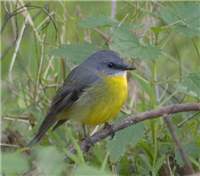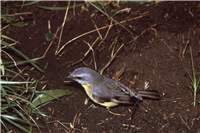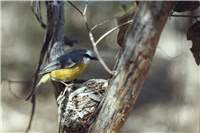Family
Petroicidae
Genus
Eopsaltria
Species
australis
Threats/Control Methods - Regional
Land clearing and urban development poses the biggest threat for this species. In the ACT, it is possible that as little as 3-4% of the original extent of the Yellow Box/Red Gum Grassy Woodland remains in something like its natural state. Worse still, the adjoining NSW woodlands only remain at 0.01% of their original extent. The invasion into suitable habitats by introduced weeds and predation by feral and uncontrolled domestic animals are also key threats.
Threats/Control Methods - Local
Not currently thought to be at risk within the ACT although habitat change and introduced species may compete for habitat or predate upon the species.
Local/Urban Actions
Canberra residents can encourage the birds into the local region by participating in tree planting or bush regeneration activities with local Landcare groups or with Greening Australia. Cat owners can prevent their pets preying on the species by providing a stimulating indoor environment and installing a cat run or enclosure.
Common Names
Eastern Yellow Robin, Southern Yellow Robin, Yellow Bob, Yellowhammer, Wild Canary, Bark, Creek, Golden-rumped, Golden-tailed or Yellow-breasted Robin
Distinguishing Features
This species is a medium sized, chunky robin, at 15-16cm. It has a large, dark eye and a small pointed beak. It is a light grey colour across its head, back and wings, however distinctive due to its bright yellow breast, underparts and rump. Wings have a white bar. Young birds are light brown with white streaks.
Survey Techniques
Call and visual identification.
Species Call
A clear, even piping whistle 'tchiep-tchiep-tchiep'. At dawn and dusk: a repeated 'chop-chop'.
Similar Species
This species is almost identical to the Western Yellow Robin (Eopsaltria griseogularis), however the two species are not seen in the same area. The Pale Yellow Robin (Tregellasia capito) has similar colourings but is smaller, paler and not seen in the Canberra region.
Distribution
This species is found across eastern Australia, with highest numbers in the coastal hinterland areas. In the Canberra region, these Robins are usually found near Black Mountain or Mount Ainslie reserves.
Country of Origin
Australia
Conservation (Pet/Pest) Status - Regional
This species is found in the forests and riverine areas around Canberra and it does not often visit the suburbs. There is a large fluctuation of population numbers from year to year and overall the species is declining. It is considered a woodland 'bird to watch out for' by Greening Australia of the ACT and SE NSW.
Conservation (Pet/Pest) Status - National
Secure, not listed under the EPBC Act 1999.
LSCCES Population
This survey found a medium number at ANBG and one at ANU.
Associated vegetation community
This species prefers dense, dark areas of forest, woodland or riverine areas with high rainfall.
Limiting Resources
Eastern Yellow Robins depend on thick vegetation and shrubs for shelter and nesting sites. They also need a reliable water source and a messy ground layer for ample insect supply.
Breeding
Birds leave the Canberra suburbs to breed in the late spring. A breeding pair can have up to 3 clutches in one season. The female builds a neat cup of bark shreds bound with spider web, camouflaged on the outside with bark and moss. This nest is usually placed on a tree fork about 5m from the ground. The 2-3 eggs are blue with light brown spots, requiring 14-15 days incubation. Both parents and helpers care for young birds for about 12 days. After 40 days they have acquired adult plumage.
Behaviour
This species is usually seen in pairs or small groups in low tree branches, clinging sideways, waiting to swoop to the ground for insects. They are inquisitive and fairly approachable.
Functional Group
Food Species
Eastern Yellow Robins feed on insects, spiders and other arthropods.
Predators
European Red Foxes (Vulpes vulpes), Dogs (Canis familiaris) and Cats (Felis catus) may attack the Robins in their woodland setting around Canberra.
Interesting Fact
The Adelaide area is the only place in Australia where bird watchers might see both Eastern and Western Yellow Robins.
References - (reader suitability of references, P=Primary teachers, S=Secondary students, T=Tertiary students and researchers)
Books:Morcombe, M. 2000. Field Guide to Australian Birds. Steve Parish Publishing. Archerfield. Australia P, S, T
Taws, N. et al. 2001. Bringing Birds Back: A Glovebox Guide for Bird Identification and Habitat Restoration in ACT and SE NSW. Greening Australia ACT and SE NSW Inc. P, S, T
Veerman, P. 2003. Canberra Birds: A report on the first 21 years of the garden bird survey. Philip Veerman and Canberra Ornithologists Group. Canberra. S, T
Internet: Birds in Backyards 2006. [online]. Available at:http://www.birdsinbackyards.net P, S, T
Canberra Ornithological Group (COG). 2004. Birds of Canberra Gardens. COG and the ACT Department of Urban Services. [online]. Available at:http://garden.canberrabirds.org.au/ P, S, T
Online Publications:ACT Government. 2004. Woodlands for Wildlife: ACT Lowland Woodland Conservation Strategy. Action Plan No. 27. Environment ACT, Canberra. [online]. Available at: http://www.environment.act.gov.au/nativeplantsandanimals/threatecspec/woodlandsstrategy S, T
Nix, H. and Cunningham, R. 2006. Birds of the Lower Sullivans Creek Catchment, Canberra ACT. Prepared for the Life in the Suburbs project using data from the Lower Sullivans Creek Catchment Ecological Survey (LSCCES). Australian National University. Canberra. [online]. Available at: http://www.lifeinthesuburbs.com.au/category.php?id=65 S, T




 Top
Top Top
Top